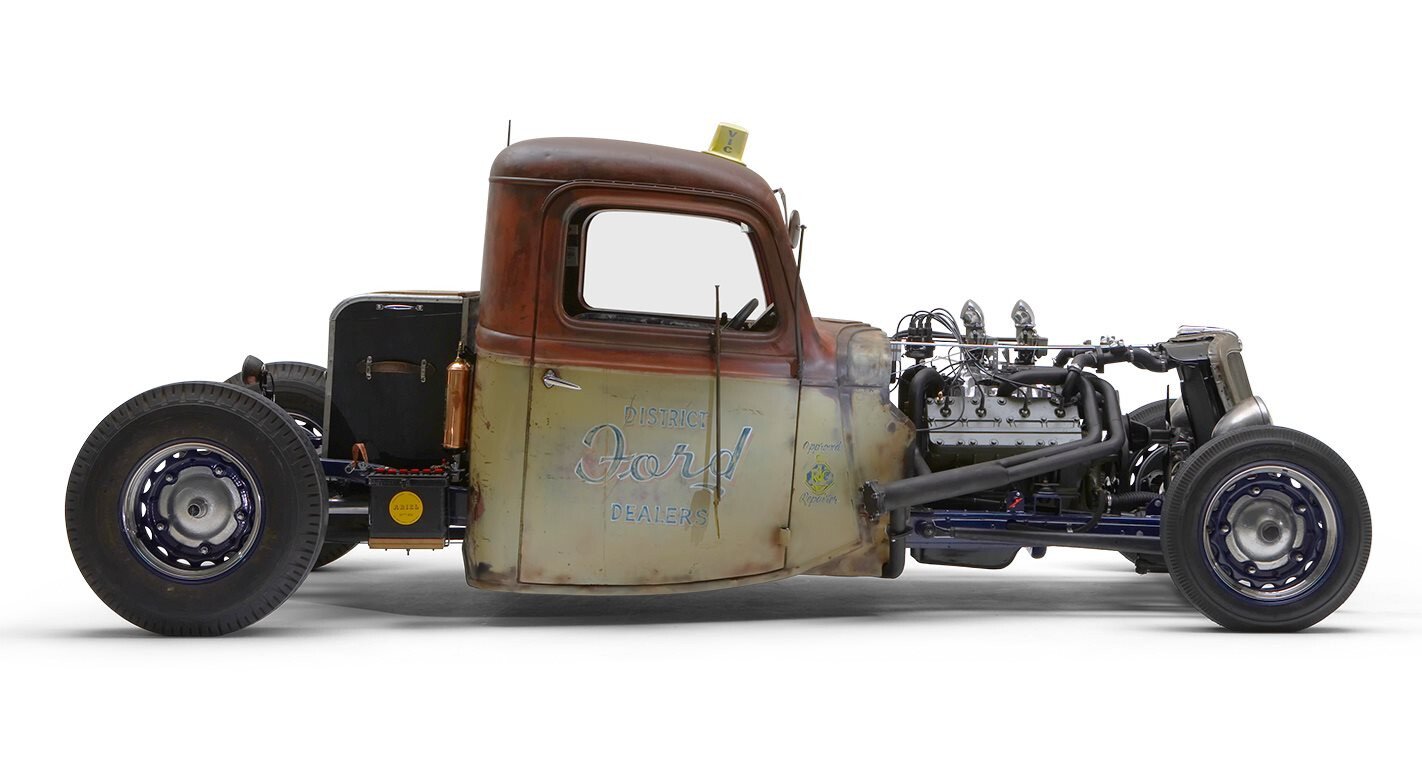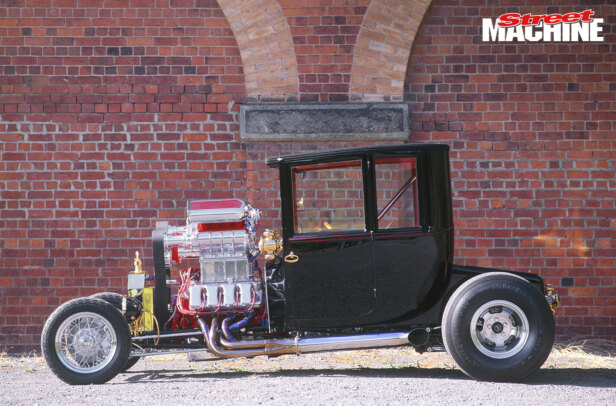This article on Rod’s Ford truck was originally published in the June 2009 issue of Street Machine
“The whole thing came about through Street Machine. I was that pissed off about the write-up they did on Billy Gibbons’ pick-up [SM, Jun ’08]. It’s a bloody piece of shit and all those American trucks look the same. Paint them black, shorten the back, put some crappy grille on it and call it a bloody pick-up; they’re all the same. I thought: ‘I’ll build something different here.’”
That’s Rod Hadfield. Never one to mince his words and never one to follow any particular trend; it’s just not his style. What he’s managed to do this time is amalgamate a bunch of disparate parts — a Dodge chassis, Ford body and Cadillac engine — and turn it into a hot rod of a kind that’s never been seen before.
You have to wonder where he finds this stuff. Maybe if you put the feelers out this stuff finds you. But where do you get your paws on a fully reconditioned 346 Cadillac flathead V8?
Rod found a bloke who had a ’47 Caddy convertible but was having problems with the original drivetrain.
“The motor and auto were reconditioned but the auto chucked it in. He got it fixed and it died again, so he put a Chevy motor and gearbox in. The motor has supposedly done only 4000 miles. When I went to pick it up I got a bit of a surprise. The diff was there as well because he’d put a nine-inch in it and — bugger me dead! — there was a spare motor in bits.”
Cadillac flatheads didn’t come with twin-carb intakes but “that’s another weird story. I started asking around for a Cadillac manual flywheel. I wanted a manual — I don’t drive autos; I’m a man — and got onto this bloke in Castlemaine who had a La Salle. I asked if he knew anyone who had a flywheel and he did. I nearly dropped dead. I got hold of the bloke and he had a clutch and pressure-plate too. He asked if I was short of anything else. I said: “I’m short of something but there’s no way in the world anyone’s going to have one; I want some kind of fancy carby manifold. He said: ‘I’ve got a triple carby one here,’ and I said: ‘Bullshit!’ It turns out it’s a home-made thing made for Cadillac carbies, so I got it and mucked around with it and adapted the two Stromberg 97s onto it because three wouldn’t fit.”
Rod’s a magnet for this stuff; the cargo trunk behind the cab also came with a few bonuses. “The trunk was made in Maldon, the next town along from Castlemaine, as a wedding present for a lady whose father, Keith Laity, was a pioneer of hillclimbing and hot rodding in this area. It’s original and inside it were some genuine RACV books, originals right back to 1950.”
The body is another interesting piece and a bit of a mystery. Supposedly from Albury, Rod found it in Ballarat. It wasn’t for sale but Rod managed to talk the guy around.
“He wanted top dollar for it but the fact was, it was all there. Where would I find a windscreen like that? It’s a one-piece one; they look much better than two pieces. Where would you find the door components or the window moulds? It was all there, the cowl vent wasn’t rusty and the firewall wasn’t all dented.”
Even the paintwork is as Rod found it, only touched up around the bottom where some rust repairs were performed. The most interesting part though, is the District Ford Dealers script on the doors. “That Ford script is pretty unique. I’ve written to Restored Cars magazine and sent a photo to ask if any readers recognise the cab or those doors. Somebody’s got to recognise it.”
Maybe someone out there in Street Machine land — or their grandfather — might recognise the truck or at least the signwriting. Rod’s pretty sure that the top was red at some stage: “Inside, the doors are red, so it’s had a red roof and then got weathered and the bottom’s been that creamy colour,” Rod says. If anyone out there remembers a red and cream ’35 Ford truck running around the streets of country Victoria, get in touch.
Rod opened the trunk and found RACV magazines dating back as far as 1950! The battery is an old EJ case that has had new internals fitted by Ariel Batteries in Melbourne
Rod could have built a chassis to suit his needs, but instead he decided to use a 1916 Dodge frame. Sounds like an odd choice, but Rod’s got his reasons.
“This chassis is the only chassis I know that’s got two widths in it. At the firewall the chassis spreads right out. Nothing looks worse than a channelled car with a big gap of body between the chassis and the edge of the body. My chassis swings out like an ‘S’ shape and I was able to hook the radius rods straight onto that bend and give them a parallel push, so it’s a lot stronger in the front-end. It looks like it’s meant to be there because it’s the same shape as the body. It’s stock standard as well.”
No, they’re not VW wheels. They’re off a ’37 to ’39 Ford and they’re called ‘wide fives’ because of their widely spaced bolt pattern
How the body sits in relation to the chassis isn’t quite how the Ford or Dodge engineers envisioned. It’s channelled around six inches front and rear and thanks to its unchopped roof, there’s plenty of headroom, even if you’re a fan of the 10-gallon hat.
“The Australian body with the higher roof looks a hell of a lot cooler. It’s a full oval roof and beautifully shaped, whereas the Yank one has a fold and then it’s flat,” Rod says.
A genuine Castlemaine Hospital stainless steel pisspot is very thankful for its new role as an overflow tank
Although the chassis is Dodge, the suspension has been updated somewhat — if you can call 1939 Ford an update. At least by then Ford had converted to hydraulic brakes, and Rod has used the front and rear axles, the wheels and even the original rear tyres from a car that was getting an updated street rod chassis. It’s recycling at its best and Rod’s plan was to try and use parts from 50 different cars in building this rod. He reckons he came pretty close, too!
The interior’s spartan but there are hundreds of little details. The pedals (not shown) are from an HR, mounted upside-down to go through the floor. Underneath the seat is a heater. Shifter handle is a busted and bent red motor conrod
The interior is minimalist, although unlike some of the US rat rods, you can’t actually see the road pass under your feet as you’re driving along — that’s not really a cool thing. There’s a fabricated bench seat that swings forward to reveal a small storage area, and various bits and pieces have been scrounged from wrecking yards to supply bare necessities.
The jury’s still out on whether we think it’s a beautiful hot rod, but it is unique, that’s for sure. Which is what Rod set out to build, and we wouldn’t expect anything less from him.
THE DONK
A. The 346ci sidevalve Caddy V8 might look kinda crazy with the exhaust ports up the top of the engine but the design keeps the hot exhaust gases away from the coolant passages, a problem that plagues traditional flathead engines. The pipes were made from torque tubes
B. Speed equipment for these engines is very hard to find, so Rod was stoked to find a triple-carb inlet manifold to suit. Which he then modified, of course
C. Those neat little caps on the radiator hoses are from a Model T and screw into custom housings that also hold the thermostats
ROD HADFIELD
1935 FORD TRUCK
Colour: Chronos
ENGINE
Brand: Cadillac flathead V8
Capacity: 346ci
Induction: Twin Stromberg 97s
Internals: Stock
Sump: Modified
Fuel pump: Electric
Cooling: ’34 Ford
Exhaust: Lakes headers, twin two-inch with stainless mufflers
Ignition: Ignition Developments, Judson coil
TRANSMISSION
Gearbox: Ford three-speed + overdrive
Diff: ’39 Ford ute, converted to open tailshaft
Tailshaft: XY, nine-inch rear uni
Clutch: Ford 302 V8 10in with hydraulic thrust bearing
Adaptor: Built to suit Caddy auto bellhousing
SUSPENSION & BRAKES
Springs: Reversed eye (f), custom built (r)
Shocks: ’34 Ford rear (f), ’34 Ford front (r)
Mods: ’34 Ford axle, three-inch drop
Steering: ’39 Ford box
Brakes: ’39 Ford (f&r)
Master cylinder: ’39 Ford
WHEELS &TYRES
Tyres: Firestone Deluxe Champion 4.50/4.75×16 (f), Remington Universal Highway 7.50×16 (r)
Wheels: 1937–’39 Ford, 16×4 (f), 16×6 (r), with trim rings on both sides




Comments